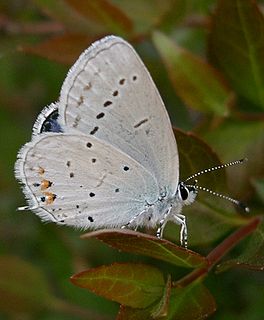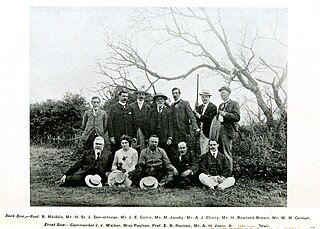Related Research Articles

Butterflies are insects in the macrolepidopteran clade Rhopalocera from the order Lepidoptera, which also includes moths. Adult butterflies have large, often brightly coloured wings, and conspicuous, fluttering flight. The group comprises the large superfamily Papilionoidea, which contains at least one former group, the skippers, and the most recent analyses suggest it also contains the moth-butterflies. Butterfly fossils date to the Paleocene, about 56 million years ago.

The superfamily Papilionoidea contains all the butterflies except for the moth-like Hedyloidea.

Lycaenidae is the second-largest family of butterflies, with over 6,000 species worldwide, whose members are also called gossamer-winged butterflies. They constitute about 30% of the known butterfly species.

Riodinidae is the family of metalmark butterflies. The common name "metalmarks" refers to the small, metallic-looking spots commonly found on their wings. The 1532 species are placed in 146 genera. Although mostly Neotropical in distribution, the family is also represented both in the Nearctic and the Palearctic.

The short-tailed blue or tailed Cupid is a butterfly that forms part of the family Lycaenidae. It is found from Europe to Japan and in India.

Lycaeninae, the coppers, are a subfamily of the gossamer-winged butterflies (Lycaenidae).

Spalgis epius, the apefly, is a small butterfly found in the Indomalayan realm that belongs to the lycaenids or blues family. It gets its name from the supposed resemblance of its pupa to the face of an ape.

Miletinae is a subfamily of the family Lycaenidae of butterflies, commonly called harvesters and woolly legs, and virtually unique among butterflies in having predatory larvae. Miletinae are entirely aphytophagous. The ecology of the Miletinae is little understood, but adults and larvae live in association with ants, and most known species feed on Hemiptera, though some, like Liphyra, feed on the ants themselves. The butterflies, ants, and hemipterans, in some cases, seem to have complex symbiotic relationships benefiting all.

Polyommatinae, the blues, are a diverse subfamily of gossamer-winged butterflies.
George Thomas Bethune-Baker was an English entomologist who specialised in Lepidoptera, especially those in the family Lycaenidae of butterflies.

Zizeeria knysna, the dark grass blue or African grass blue, is a species of blue butterfly (Lycaenidae) found in Africa, on Cyprus and the Iberian Peninsula.

Spalgis is a genus of butterflies in the family Lycaenidae. Spalgis are found in the Australasian realm, the Indomalayan realm, and the Afrotropical realm. The genus was erected by Frederic Moore in 1879.

Hamilton Herbert Charles James Druce was an English entomologist who specialised in Lycaenidae and to a lesser extent Hesperiidae. He is not to be confused with his father, the English entomologist Herbert Druce (1846–1913) who also worked on Lepidoptera.
Spalgis jacksoni is a butterfly in the family Lycaenidae. It is found in Uganda and Tanzania.

Spalgis lemolea, the lemolea harvester or African apefly, is a butterfly in the family Lycaenidae. The species was first described by Hamilton Herbert Druce in 1890. It is found in Senegal, the Gambia, Guinea-Bissau, Guinea, Liberia, Ivory Coast, Ghana, Togo, Nigeria, Cameroon, from Gabon to Ethiopia, the Democratic Republic of the Congo, Uganda, Kenya, Malawi, Zambia, northern Zimbabwe and Botswana. The habitat consists of forests and dense savannah, as well as thick riverine bush.
Henri Stempffer was a French entomologist who specialized in the study of Lycaenidae butterflies.
References
| Wikimedia Commons has media related to Spalgis tintinga . |
| Wikispecies has information related to Spalgis tintinga . |
- ↑ Spalgis at Markku Savela's Lepidoptera and Some Other Life Forms
- ↑ Afrotropical Butterflies: Lycaenidae - Subtribe Spalgina
| This Miletinae-related article is a stub. You can help Wikipedia by expanding it. |